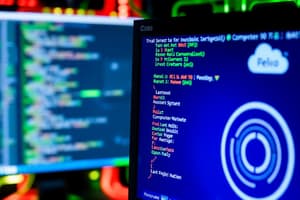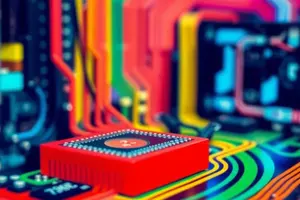Podcast
Questions and Answers
¿Cuál de los siguientes dispositivos convierte los datos procesados por la CPU en una forma que los usuarios pueden entender?
¿Cuál de los siguientes dispositivos convierte los datos procesados por la CPU en una forma que los usuarios pueden entender?
- Teclados
- Escáneres
- Routers
- Impresoras (correct)
¿Qué tipo de software se encarga de gestionar los recursos de hardware de la computadora?
¿Qué tipo de software se encarga de gestionar los recursos de hardware de la computadora?
- Sistemas operativos (correct)
- Navegadores web
- Editores de fotos
- Juegos
¿Cuál de las siguientes NO es una categoría válida de software mencionada en el texto?
¿Cuál de las siguientes NO es una categoría válida de software mencionada en el texto?
- Software de entretenimiento
- Sistemas de refrigeración (correct)
- Suites de productividad
- Simuladores médicos
¿Qué tipo de red puede ser tanto alámbrica como inalámbrica?
¿Qué tipo de red puede ser tanto alámbrica como inalámbrica?
¿Cuál es el propósito principal de las aplicaciones de software?
¿Cuál es el propósito principal de las aplicaciones de software?
¿Cuál es la función principal de la longitud en la geografía?
¿Cuál es la función principal de la longitud en la geografía?
¿Qué punto geográfico marca el comienzo de la longitud en la Tierra?
¿Qué punto geográfico marca el comienzo de la longitud en la Tierra?
¿Qué indican los valores positivos y negativos de la longitud en relación con el Meridiano de Greenwich?
¿Qué indican los valores positivos y negativos de la longitud en relación con el Meridiano de Greenwich?
¿Qué papel juegan los Trópicos de Cáncer y Capricornio en relación con la posición del sol en la Tierra?
¿Qué papel juegan los Trópicos de Cáncer y Capricornio en relación con la posición del sol en la Tierra?
¿Por qué es crucial comprender las coordenadas geográficas de latitud y longitud?
¿Por qué es crucial comprender las coordenadas geográficas de latitud y longitud?
Flashcards are hidden until you start studying
Study Notes
Computers: A Comprehensive Overview of Hardware and Software
Introduction
Computers are an integral part of modern life. They are used in various settings, from personal computers for everyday tasks to supercomputers for complex scientific research. This article provides an in-depth exploration of computers, focusing on the subtopics of hardware and software.
Hardware
Hardware refers to the physical components of a computer. It includes the central processing unit (CPU), main memory, secondary storage devices, input devices, output devices, and network components.
-
Central Processing Unit (CPU): The CPU is the brain of the computer. It performs the calculations and executes instructions. In the earliest computers, CPUs were large, electromechanical devices. Today, CPUs are microprocessors, small chips that can execute billions of instructions per second.
-
Main Memory: Main memory, also known as random access memory (RAM), is used to temporarily store data that the CPU needs to access quickly. It is classified by storage capacity, access speed, data rate, and configuration.
-
Secondary Storage Devices: These include hard disk drives (HDDs) and solid-state drives (SSDs), which are used to store data permanently. They are slower than main memory but can store large amounts of data.
-
Input Devices: Input devices, like keyboards, mice, and touchscreens, allow users to interact with the computer. They convert user input into a form the CPU can process.
-
Output Devices: Output devices, such as monitors, printers, and speakers, display or produce the results of the computer's processing. They convert the data processed by the CPU into a form users can understand.
-
Network Components: Computers are often connected to a larger network system for transmitting data and information. Networks can be wired or wireless, and include local area networks (LANs) and wide area networks (WANs).
Software
Software is the set of programs and related data that enable a computer to perform specific tasks. It includes operating systems, applications, and system utilities.
-
Operating Systems: An operating system (OS) manages the computer's hardware resources and provides a platform for running applications. Examples include Windows, macOS, and Linux.
-
Applications: Applications are software programs designed to perform specific tasks. They can range from productivity suites to games to scientific simulations.
-
System Utilities: System utilities are software tools that help manage and maintain the computer's hardware and software. They can include disk utilities, security software, and system maintenance tools.
Conclusion
This article has provided an overview of computers, focusing on the subtopics of hardware and software. Computers are complex systems that involve both physical components and software programs. Understanding these components is essential for effectively using and maintaining computers.
Studying That Suits You
Use AI to generate personalized quizzes and flashcards to suit your learning preferences.




